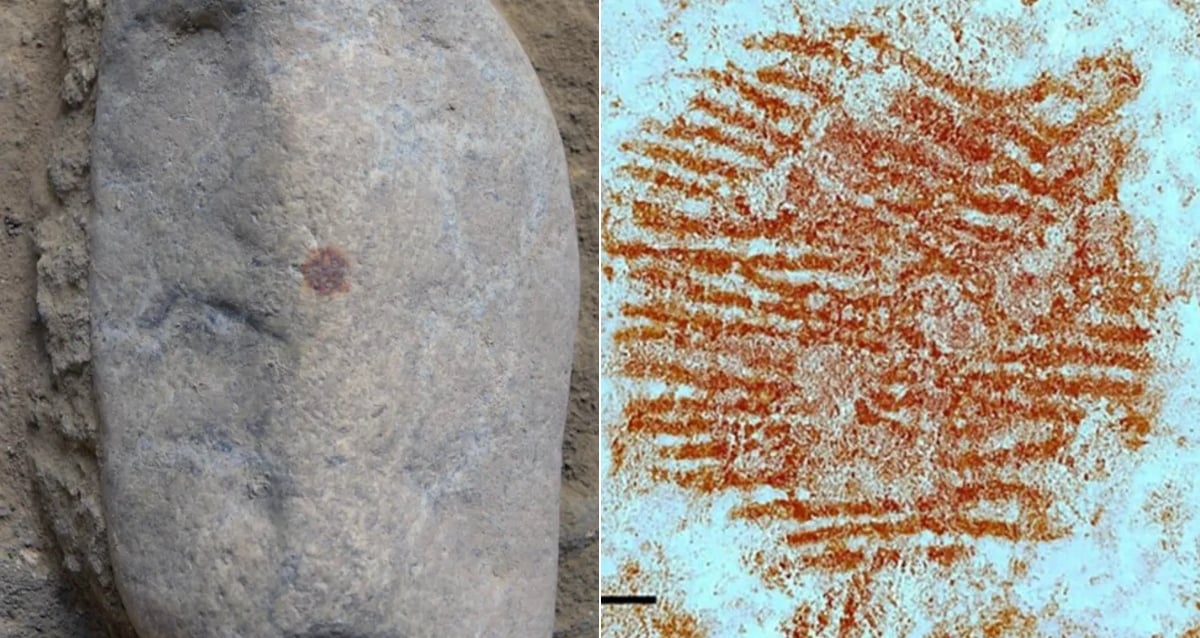Ancient Mystery Unveiled: Neanderthal’s 43,000-Year-Old Fingerprint Discovered in Spain Challenges History
Ever wonder if Neanderthals were the original “finger painters” of the ancient world? Turns out, a tiny red fingerprint pressed onto a stone some 43,000 years ago might just be the earliest doodle of a face crafted by our prehistoric cousins. Archaeologists digging in Spain stumbled upon this oddly shaped rock, complete with a strategically placed red dot—like a primitive nose—that sparked a flurry of excitement. Could this small mark reveal that Neanderthals not only saw faces but also had the abstract smarts to create symbolic art? It might just rewrite the story we’ve been telling about our early relatives, showing that artistic flair isn’t solely a Homo sapiens party trick after all. So next time you think you’ve got a mess on your fingers, remember: 43,000 years ago, that could’ve been considered a masterpiece! LEARN MORE
Researchers believe this fingerprint was meant to form a face on a stone, perhaps making this one of the earliest works of art ever created by our early human cousins.

Álvarez-Alonso et al.The small red fingerprint on this rock is believed to have been placed there by a Neanderthal who was attempting to make a primitive work of art.
Archaeologists in Spain recently unearthed a rock that somewhat resembled a human face, especially because of a small red dot where the nose would be. Now, the story behind that dot has left researchers truly amazed as they’ve discovered that it’s the world’s oldest known fingerprint.
Some 43,000 years ago, it seems that a Neanderthal’s attention was also captured by this face-shaped rock, and he decided to add a little detail of his own. Experts claim the Neanderthal male dipped his finger into a red pigment and then pressed a small dot onto the stone, giving it a nose.
If this analysis is correct, the implications could be enormous. Based on the “strategic position” of the dot, scientists now see it as a sign of “symbolic behavior,” meaning Neanderthals could think about things in an abstract way.
While this doesn’t settle the debate about Neanderthals’ ability to create art, it does certainly make a compelling argument that they could.
A Prehistoric Red Dot Found On A Stone In Spain Captures Archaeologists’ Attention
In 2022, a team of researchers began digging at the San Lázaro rock shelter in Segovia, Spain, when they came across a peculiar 7.8-inch stone.
“The stone was oddly shaped and had a red ochre dot, which really caught our eye,” David Álvarez Alonso, an archaeologist at Complutense University in Madrid, told The Guardian. “We were all thinking the same thing and looking at each other because of its shape: we were all thinking, ‘This looks like a face.’”
Of course, humans recognizing a face in an object is nothing new. Humans are hardwired to see patterns in objects, and seeing faces — a psychological phenomenon known as pareidolia — is highly common. However, this typically only applies to Homo sapiens.

Pedro A. Saura RamosDetail of the red dot made by a Neanderthal 43,000 years ago.
But what if our prehistoric Neanderthal cousins were also wired the same way?
“As we carried on our research, we knew we needed information to be able to advance the hypothesis that there was some purposefulness here, this was a symbolic object and that one possible explanation – although we’ll never know for sure – is that this was the symbolization of a face,” Álvarez Alonso said.
To try and prove their theory, the team enlisted other experts, which led to a few interesting findings. Firstly, the red pigment used on the stone was not found anywhere else in the cave — a clear indication that its placement was intentional.
Then, during multi-spectrum analysis, they identified a fingerprint, one belonging to an adult Neanderthal male.
The World’s Oldest Fingerprint Provides Insight Into Neanderthals’ Minds
The team just published their findings in the journal Archaeological and Anthropological Sciences, writing, “The fact that the pebble was selected because of its appearance and then marked with ocher shows that there was a human mind capable of symbolizing, imagining, idealizing, and projecting his or her thoughts on an object.”
The red dot — and the fingerprint — was the key to this theory. With no other similar marks in the cave, and the fact that the pigment was manmade and not natural, there was enough evidence to suggest that the placing of the dot was intentional.
“It couldn’t have been a coincidence that the dot is where it is – and there are no markings to indicate any other use,” Álvarez Alonso added. “So why did they bring this pebble from the river to the inside of the cave? And, what’s more, there’s no ochre inside the cave or outside it. So they must have had to bring pigment from elsewhere.”

Álvarez-Alonso et al.The Neanderthal fingerprint, fully revealed during multi-spectrum analysis.
As the BBC reported, Spanish officials highlighted the remarkable nature of this discovery during a news conference. Official Gonzalo Santonja noted in particular that this rock is “the only object of portable art painted by Neanderthals” — at least, the only one that’s ever been found.

















